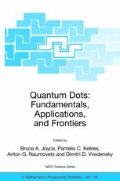Abstract
An efficient method for calculation of self-assembled dot states within the effective mass approximation is described and its application to the calculation of Auger relaxation rates is detailed. The method is based on expansion of the dot states in a harmonic oscillator basis whose parameters are optimised to improve the convergence rate. This results in at least an order of magnitude reduction in the number of basis states required to represent electron states accurately compared to the conventional plane wave approach. Auger relaxation rates are calculated for harmonic oscillator model states and exact states for various pyramidal models. The dipole approximation, previously used to calculate Auger rates, is found to be inaccurate by a factor of around 2–3. The harmonic oscillator states do not reproduce the rates for the more realistic pyramidal models very well and even within the set of pyramidal models variations in the dot shape and size can change the rates by up to an order of magnitude. Typical Auger relaxation rates are on a picosecond timescale but the actual value is strongly dependent on the density of electrons outside the dot.
Access this chapter
Tax calculation will be finalised at checkout
Purchases are for personal use only
Preview
Unable to display preview. Download preview PDF.
References
P. M. Petroff, A. Lorke, and A. Imamoglu. Epitaxially self-assembled quantum dots. Physics Today 54(5): 46–52, 2001.
M. Grundmann, O. Stier, and D. Bimberg. InAs/GaAs pyramidal quantum dots: Strain distribution, optical phonons, and electronic-structure,” Phys. Rev. B 52: 11969–11981, 1995.
M. A. Cusack, P. R. Briddon, and M. Jaros. Electronic structure of InAs/GaAs self-assembled quantum dots. Phys. Rev. B. 54: R2300–R2303, 1996.
J. A. Barker and E. P. O'Reilly. The influence of inter-diffusion on electron states in quantum dots. Physica E 4: 231–237, 1999.
J. A. Barker and E. P. O'Reilly. Theoretical analysis of electron-hole alignment in InAs-GaAs quantum dots. Phys. Rev. B bf 61: 13840–13851, 2000.
M. Roy and P. A. Maksym (2003). Efficient method for calculating electronic states in self-assembled quantum dots. Phys. Rev. B 68: art. no. 235308 (2003)
D. Chaney, M. Roy, P. A. Maksym, and F. Long. The effect of self-assembled quantum dot geometry on Auger relaxation rate. Proc. 26th Int. Conf. on the Physics of Semiconductors, edited by A. R. Long and J. H. Davies (Bristol, IOP Publishing, 2003).
A. V. Uskov, F. Adler, H. Schweizer, and M. H. Pikuhn. Auger carrier relaxation in self-assembled quantum dots by collisions with two-dimensional carriers. J. Appl. Phys. 81: 7895–7899, 1997.
P. B. Joyce, T. J. Krzyzewski, G. R. Bell, B. A. Joyce and T. S. Jones. Composition of InAs quantum dots on GaAs(001): Direct evidence for (In,Ga)As alloying,” Phys. Rev. B 58: R15981–R15984, 1998.
N. Liu, J. Tersoff, O. Baklenov, A. L. Holmes, and C. K. Shih. Nonuniform composition profile in In0.5Ga0.5As alloy quantum dots. Phys. Rev. Lett. 84:334–337, 2000.
P. W. Fry, I. E. Itskevich, D. J. Mowbray, M. S. Skolnick, J. J. Finley, J. A. Barker, E. P. O'Reilly, L. R. Wilson, I. A. Larkin, P. A. Maksym, M. Hopkinson, M. Al-Khafaji, J. P. R. David, A. G. Cullis, G. Hill, and J. C. Clark. Inverted electron-hole alignment in InAs-GaAs self-assembled quantum dots. Phys. Rev. Lett. 84: 733–736, 2000.
D. M. Bruls, J. W. A. M. Vugs, P. M. Koenraad, M. S. Skolnick, M. Hopkinson, F. Long, S. P. A. Gill, and J. H.Wolter. Determination of the shape and indium distribution of low-growth-rate InAs quantum dots by cross-sectional scanning tunnelling microscopy. Appl. Phys. Lett. 81: 1708–1710, 2002.
M. R. Bruni, A. Lapiccirella, G. Scavia, M. G. Simeone, S. Viticoli, and N. Tomassini. Thermodynamic study of molecular-beam epitaxial-growth of In-GaAs/GaAs strained layer superlattices. Thermochemica Acta. 210, 49–65, 1992.
L. R. C. Fonseca, J. L. Jimenez, J. P. Leburton, and R. M. Martin. Selfconsistent calculation of the electronic structure and electron-electron interaction in self-assembled InAs-GaAs quantum dot structures,” Phys. Rev. B 57:4017–4026, 1998.
O. Stier, M. Grundmann, and D. Bimberg. Electronic and optical properties of strained quantum dots modelled by 8-band k · p theory. Phys. Rev. B 59:5688–5701, 1999.
D. Morris, N. Perret and S. Fafard. Carrier energy relaxation by means of Auger processes in InAs/InGaAs self-assembled quantum dots. Appl. Phys. Lett. 75: 3593–3595, 1999.
B. Liu, Q. Li, Z. Xu and W. E. Ge. Detection of efficient carrier capture in ultrathin InAs/GaAs layers using a degenerate pump-probe technique. J. Phys: Condens. Matter 13: 3923–3930, 2001.
Author information
Authors and Affiliations
Editor information
Editors and Affiliations
Rights and permissions
Copyright information
© 2005 Springer
About this paper
Cite this paper
Chaney, D., Roy, M., Maksym, P.A. (2005). Efficient Calculation of Electron States in Self-Assembled Quantum Dots: Application to Auger Relaxation. In: Joyce, B.A., Kelires, P.C., Naumovets, A.G., Vvedensky, D.D. (eds) Quantum Dots: Fundamentals, Applications, and Frontiers. NATO Science Series, vol 190. Springer, Dordrecht. https://doi.org/10.1007/1-4020-3315-X_16
Download citation
DOI: https://doi.org/10.1007/1-4020-3315-X_16
Publisher Name: Springer, Dordrecht
Print ISBN: 978-1-4020-3313-1
Online ISBN: 978-1-4020-3315-5
eBook Packages: Chemistry and Materials ScienceChemistry and Material Science (R0)

